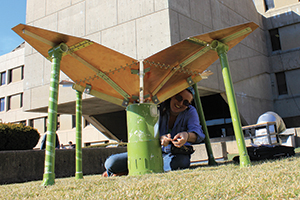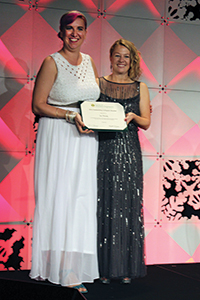Exploring the Cosmic Dawn
By Jocelyn Duffy
When most people pack their bags for
a trip to an island, they pack swimsuits
and sunscreen. Tabitha Voytek, a
doctoral student in physics, packs …
a telescope.
 At full size, the telescope is only a couple of meters wide and looks like a large four-petaled flower. Its petals fold up so that it fits into a container no bigger than standard-sized luggage, allowing Voytek to take it to some of the most remote locations in the world.
At full size, the telescope is only a couple of meters wide and looks like a large four-petaled flower. Its petals fold up so that it fits into a container no bigger than standard-sized luggage, allowing Voytek to take it to some of the most remote locations in the world.
Called Sonda Cosmologica de las Islas para la deteccion de Hidrogeno neutro, or SCI-HI for short, the telescope is a low-frequency radio telescope. SCI-HI collects information about the universe during the “Cosmic Dawn,” a period of time approximately 10 billion years ago — around 1 billion years after the Big Bang — when the first stars formed.
Physics Ph.D. student Tabitha Voytek (pictured above) works with SCI-HI, her low-frequency radio telescope that collects information about the universe when the first stars formed approximately 10 billion years ago.
The radio telescope finds this information in the 21-centimeter line of neutral hydrogen atoms that exist in the gas around stars and galaxies.
“We’re trying to understand the history of how the first stars heated up the gas around them, which will give us a picture of an historical era about which we currently have no data,” Voytek said.Voytek built the telescope in a lab at CMU through a joint collaboration between her adviser, Physics Professor Jeffrey Peterson, and a research group from Mexico’s National Institute of Astrophysics, Optics and Electronics.
The telescope observes electromagnetic radiation at around 40-130 MHz, which makes it impossible to get readings from the 21-cm line in populated areas due to interference from man-made radio signals. FM radio, for example, operates right in the middle of that band, at around 88 to 108 MHz. To get unimpeded data, Voytek and other 21-cm cosmologists must go to unpopulated areas that are free of television, radio and even cellphones, like Isla Guadalupe, an uninhabited island off the coast of Mexico’s Baja California peninsula.
To get there, Voytek’s research team “hitchhikes” on a Mexican naval ship, which is standard practice for researchers and other visitors headed to the island. The group is forced to camp on the ship’s deck for two nights with their fellow transients until they reach their destination.
When they arrive, they bunk with local lobster and abalone fishermen who are stationed on the island. They have unreliable access to electricity and no running water. But it’s all worth it for the “clear” skies.
Voytek and her collaborators are planning their next trips that will take them, and the telescope, to Mexico’s Isla Socorro and Isla Clarion, and South Africa’s Marion Island,  which is close to Antarctica.
which is close to Antarctica.
When she’s not bringing data back from a deserted island, Voytek is bringing radio astronomy to the public, conducting public lectures on the topic and working with the Entertainment Technology Center and Pittsburgh’s Carnegie Science Center to create a planetarium show called the “The Hydrogen Sky.”
She is also an active member of the Society of Women Engineers (SWE). As part of the group, Voytek has participated in a number of K-12 outreach programs, served as the society’s graduate member coordinator and volunteered as a collegiate leadership coach, training SWE student sections on leadership skills, among other activities. For her work, Voytek won the 2014 SWE’s outstanding collegiate member award (pictured left). She was one of 10 women to receive the award this year.
Voytek first joined SWE as an undergraduate engineering student at the University of the Pacific in California; she continued her involvement after coming to CMU for her graduate work in physics.
“A lot of the challenges I face as a female grad student in physics aren’t all that different from the challenges of the female engineering Ph.D.s,” Voytek said. “SWE has emerged as the preeminent organization advocating for women in STEM.”
